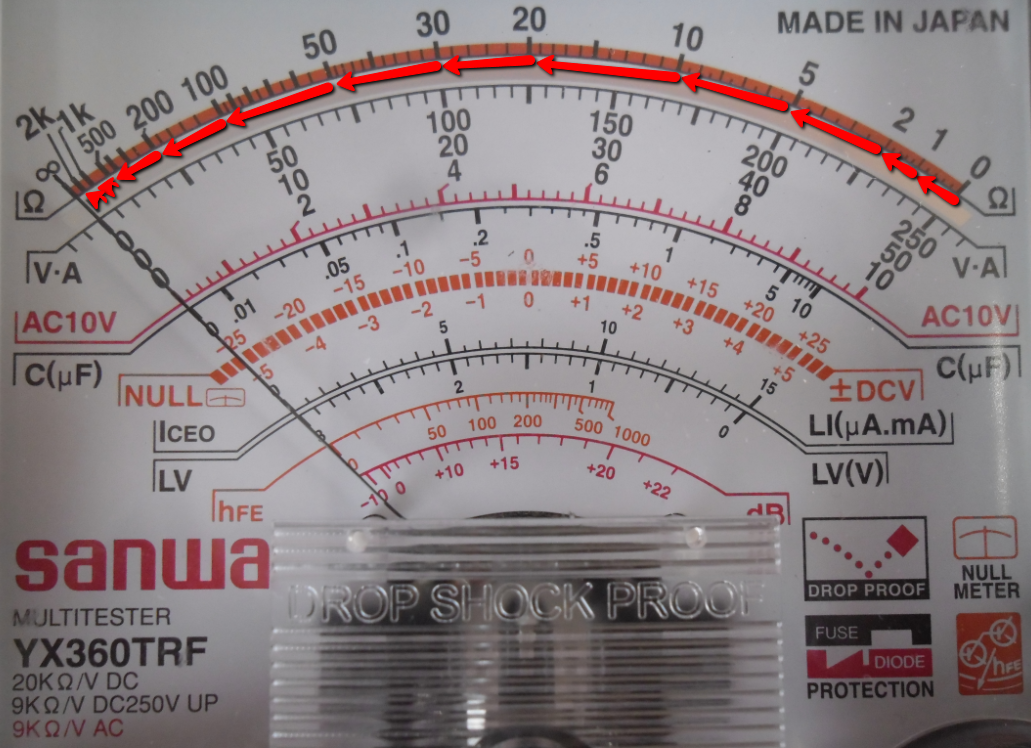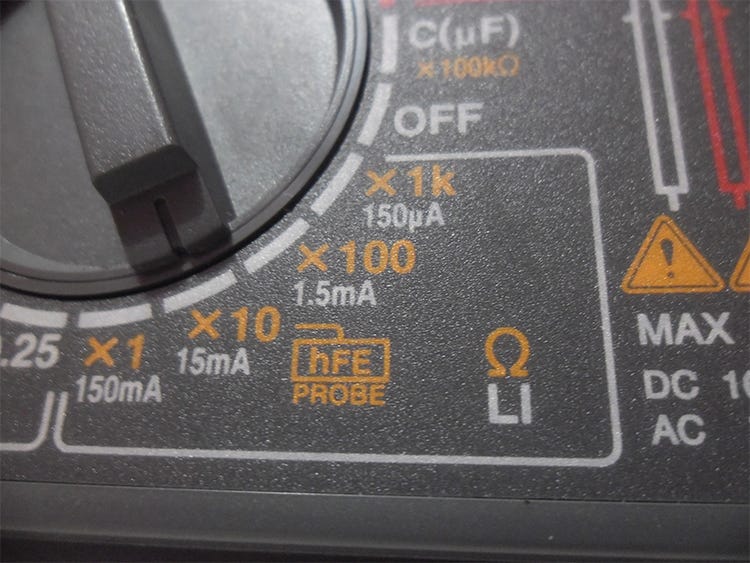How to Read Ohms on an Analog Multimeter
Measuring resistance on electronic components whether doing it individually or in-circuit, is not uncomplicated unless yous had learned how to read resistance scale using an ohmmeter of an analog multi-tester. It's not as difficult equally you think possibly by looking the overwhelming numbers and values. Once you understand it, you will realize how elementary information technology is.
As you tin see in the image below, resistance scale is located in the top most part of a meter console. You may accept noticed a descending gild of number. From left (∞) to right (0). In exercise, reading values always starts from zero. Therefore we will read resistance values from right to left which is zero (0) to infinity (∞) .
Notation: Reading resistance values is an verbal opposite of reading "voltage" and "current" since ACV (Ac voltmeter) and DCV (Dc voltmeter) scale is in ascending club. You may accept noticed how their values starts from left (0, 0, 0) to right (10, l, 250).
Since we will read resistance values from right to left, see to it that the gaps between numbers are not as divided. Please don't get so dislocated why it is non equal. In fact, it'due south non a big bargain. After all what we need to learn is the value of each scale between each numbers. Those small vertical lines that divide on each number is a scale. Each scale has a value with respect to each nearest number.

- To fully understand it, nosotros will make a list of numbers from goose egg (0) to infinity (∞) with its individual scale and value.
- Run across the carmine lines beneath the resistance scale and compare it to the list below.
0–1 — is divided by 5 scales. Each calibration has a value of 0.2 ohm. Therefore 0.2 ohm multiplied by five scales is equal to i ohm.
1–2 — also divided past v scales. Each calibration has a value of 0.two ohm. Therefore 0.2 ohm multiplied by 5 scales is equal to 1 ohm. Adding all the value from zippo, nosotros go a full of two ohms.
2–5 — is divided by vi scales. Each calibration has a value of 0.five ohm. Therefore 0.five ohm multiplied by 6 scales is equal to three ohms. Calculation all the value from zero, we get a full of 5 ohms.
5–x — is divided past ten scales. Each scale has a value of 0.5 ohm. Therefore 0.5 ohm multiplied by 10 scales is equal to 5 ohms. Adding all the value from zero, we get a full of 10 ohms.
10–20 — is divided by x scales. Each scale has a value of i ohm. Therefore 1 ohm multiplied by 10 scales is equal to 10 ohms. Adding all the value from aught, we get a total of 20 ohms.
20–thirty — is divided past 5 scales. Each scale has a value of ii ohms. Therefore 2 ohms multiplied by 5 scales is equal to 10 ohms.
Adding all the value from zilch, we get a total of xxx ohms.
30–l — is divided past x scales. Each scale has a value of 2 ohms. Therefore ii ohms multiplied by ten scales is equal to 20 ohms. Calculation all the value from null, we get a total of 50 ohms.
50–100 — is divided by ten scales. Each scale has a value of v ohms. Therefore v ohms multiplied past 10 scales is equal to 50 ohms. Calculation all the value from zero, nosotros go a total of 100 ohms.
100–200 — is divided by 5 scales. Each scale has a value of 20 ohms. Therefore 20 ohms multiplied by 5 scales is equal to 100 ohms. Adding all the value from zero, nosotros get a total of 200 ohms.
200–500 — is divided by 4 scales. Each scale has a value of 75 ohms. Therefore 75 ohms multiplied by four scales is equal to 300 ohms. Adding all the value from zero, nosotros get a total of 500 ohms.
500–1k — is not divided by a calibration. Therefore from 500, you will get the value of ane kilo-ohms (1K) past calculation 500 ohms. So, it is very obvious that the gap betwixt 500 ohms and 1k is 500 ohms. Adding all the value from cipher, we get a total of 1 kilo-ohms (1K).
1k-2k — is non divided by a scale. Therefore from 1K, you will get the value of 2k by adding 1K. So, the gap is obviously i kilo-ohms (1K). Adding all the value from cypher, we become a total of 2 kilo-ohms (2K).
Note: G stands for Kilo which ways Chiliad.
Any value that goes beyond 2K or 2 kilo-ohms value has a very high resistance and exceed the x1 multiplier range of an ohmmeter.
Please note that the highest resistance scale is just express to 2k or 2 kilo-ohm resistance. If you need to measure resistance which is college than two kilo-ohms, set the ohmmeter range to a higher multiplier range and and then on.
Learning to read resistance values is easy. Just by knowing the value of each scale individually could fulfill it. Simply there's more to learn if you dig deeper.
Hither are the questions that arises on your thoughts:
What is a multiplier?
These are the 4 range of an ohmmeter, as you can see in the paradigm below. An ohmmeter is divided by iv main settings.
a) x1 — select this range so that whatsoever value in the resistance scale is multiplied by one.
b) x10 — select this range so that any value in the resistance scale is multiplied by x.
c) x100 — select this range so that any value in the resistance scale is multiplied by 100.
d) x1k — select this range so that whatsoever value in the resistance scale is multiplied past 1k or ane thousand.
Does each range is has its own sensitivity?
- x1 — has the everyman sensitivity
- x1k — has the highest sensitivity
What range should be used in resistance measurement?
- x1 — Select this range if you are measuring resistance below ii kilo-ohms.
- x10 — Select this range if yous are measuring resistance below 20 kilo-ohms.
- x100 — Select this range if y'all are measuring resistance below 200 kilo-ohms.
- x1k — Select this range if you are measuring resistance beneath two mega-ohms.

Learning resistance measurement is simple but you need to practice. Familiarize the value of each scale and memorize information technology. Put information technology in do, measure out the resistance of an bodily electronic components such equally resistors, transistors and diodes. It'due south not very long you realize you'd already done information technology with ease.
If i missed something or messes something up, please put it in the comments below and i'll gladly make an update right abroad.
How to Read Ohms on an Analog Multimeter
Source: https://medium.com/@phillipfixit/how-to-read-resistance-scale-in-analog-multi-tester-fa655ccf4ba4